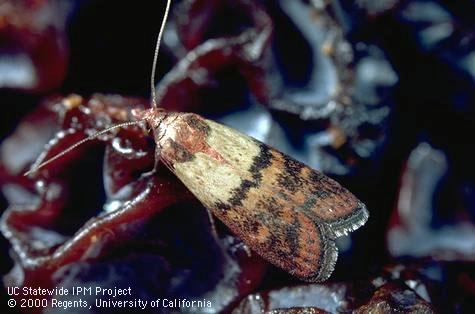[From the July 2015 issue of the UC IPM Retail Nursery and Garden Center IPM News]

What are Pantry Pests?
Beetles and moths are the two most common groups of pantry pest insects encountered in California. The most common pantry moth is the Indian meal moth. Adults are small (about 1/3 inch), with characteristically broad-banded 
Several species of beetles feed on stored food products, including the warehouse beetle, sawtoothed grain beetle (Figure 2), and the drugstore beetle, just to name a few.
While adult pantry beetles and moths are easy to tell apart, it is often the larvae that are found in the grain or flour; and these can be challenging to distinguish. Beetle larvae (Figure 3) are either grublike and legless or have three distinct pairs of legs, all located near the head. Moth larvae (Figure 4) 
Damage
Pantry pests consume food but also can contaminate food with their bodies and by-products. Indian meal moth larvae produce frass (excrement) and webbing, and some beetle larvae produce secretions that give food a disagreeable odor and taste, or microbes that can produce carcinogenic compounds. Warehouse beetles have setae (hairs) that can irritate the mouth, throat, and stomach of people who eat infested products.
Prevention is Key
The keys to controlling these pests in the home are prevention and sanitation. Some important considerations include:
- Inspect newly-purchased grain products (including bird seed and dried pet food), nuts, dried fruits, potato chips, spices, and other foods of plant origin for signs of infestation.
- Seal any infested products in a plastic bag and dispose of them in an outside trash receptacle.
- Transfer pest-free products to hard-walled containers (glass, metal, hard plastic) that can be tightly sealed. Plastic bags aren't adequate, as they develop tiny holes over time and because they can't always be reliably sealed.
- Vacuum up any spilled products within food storage areas, including any crumbs or debris in shelving cracks and crevices or beneath shelf paper. Follow this up with a good wipe-down with soapy water.
Some pantry pests can survive on other items in the house; if the infestation persists despite cleaning up the kitchen areas, consider inspecting the rest of the house. Art made of grain, nuts, or seeds; woolen articles; stored furs; animal skins; rodent droppings; and even uncontained aspirin or other pharmaceuticals can be used as a food source by some pests. Others can survive on dead insects, so wall voids and attic spaces may have to be checked as well.
Use traps to monitor
Many home improvement stores and retail garden centers sell pheromone traps which can be used to monitor for pantry pests and to help in managing pest outbreaks. Using traps alone, however, will not successfully control pantry pests if the measures above have not been taken to clean up and prevent pest invasion and reintroduction. Also, pheromone traps are pest-specific, so identify pests first, read labels carefully, and be certain you are steering customers to the right trap. Place the traps within or near the previously-infested area and to check them weekly. Most traps remain effective for about three months. Newly trapped insects are a sign that stored foods may be infested and should be inspected or that hidden pupating larvae from a previous infestation have emerged as adults.
Find information on identifying, preventing, and managing pantry pests on the UC IPM website at www.ipm.ucdavis.edu/PMG/PESTNOTES/pn7452.html.
Author - Associate Director for Urban & Community IPM/ Area Urban IPM Advisor